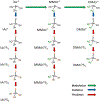Improving the predictive value of bioaccessibility assays and their use to provide mechanistic insights into bioavailability for toxic metals/metalloids - A research prospectus
- PMID: 34092204
- PMCID: PMC8390437
- DOI: 10.1080/10937404.2021.1934764
Improving the predictive value of bioaccessibility assays and their use to provide mechanistic insights into bioavailability for toxic metals/metalloids - A research prospectus
Abstract
Widespread contamination of soil, dust, and food with toxic metal(loid)s pose a significant public health concern. Only a portion of orally ingested metal(loid) contaminants are bioavailable, which is defined as the fraction of ingested metal(loid)s absorbed across the gastrointestinal barrier and into systemic circulation. Bioaccessibility tools are a class of in vitro assays used as a surrogate to estimate risk of oral exposure and bioavailability. Although development and use of bioaccessibility tools have contributed to our understanding of the factors influencing oral bioavailability of metal(loid)s, some of these assays may lack data that support their use in decisions concerning adverse health risks and soil remediation. This review discusses the factors known to influence bioaccessibility of metal(loid) contaminants and evaluates experimental approaches and key findings of SW-846 Test Method 1340, Unified BARGE Method, Simulated Human Intestinal Microbial Ecosystem, Solubility Bioaccessibility Research Consortium assay, In Vitro Gastrointestinal model, TNO-Gastrointestinal Model, and Dutch National Institute for Public Health and the Environment bioaccessibility models which are used to assess oral absolute bioavailability and relative bioavailability in solid matrices. The aim of this review was to identify emerging knowledge gaps and research needs with an emphasis on research required to evaluate these models on (1) standardization of assay techniques and methodology, and (2) use of common criteria for assessing the performance of bioaccessibility models.
Keywords: Ingestion; bioaccessibility; exposure; metals; relative bioavailability (RBA).
Figures

Similar articles
-
Bioaccessibility and human health risk assessment of metal(loid)s in soil from an e-waste open burning site in Agbogbloshie, Accra, Ghana.Chemosphere. 2020 Feb;240:124909. doi: 10.1016/j.chemosphere.2019.124909. Epub 2019 Sep 18. Chemosphere. 2020. PMID: 31550590
-
Metal(loid) bioaccessibility and children's health risk assessment of soil and indoor dust from rural and urban school and residential areas.Environ Geochem Health. 2020 May;42(5):1291-1303. doi: 10.1007/s10653-019-00415-2. Epub 2019 Sep 12. Environ Geochem Health. 2020. PMID: 31515640
-
Considering the bioavailability and bioaccessibility of metal(loid)s for risk assessment of soils affected by different non-ferrous metal activities in Southwest China.J Hazard Mater. 2024 Jul 5;472:134527. doi: 10.1016/j.jhazmat.2024.134527. Epub 2024 May 6. J Hazard Mater. 2024. PMID: 38735184
-
A critical review of approaches and limitations of inhalation bioavailability and bioaccessibility of metal(loid)s from ambient particulate matter or dust.Sci Total Environ. 2017 Jan 1;574:1054-1074. doi: 10.1016/j.scitotenv.2016.09.056. Epub 2016 Oct 14. Sci Total Environ. 2017. PMID: 27672736 Review.
-
Assessing the bioavailability and bioaccessibility of metals and metalloids.Environ Sci Pollut Res Int. 2015 Jun;22(12):8802-25. doi: 10.1007/s11356-013-1820-9. Epub 2013 Jun 14. Environ Sci Pollut Res Int. 2015. PMID: 23764979 Review.
Cited by
-
Successful Conversion of Pb-Contaminated Soils to Low-Bioaccessibility Plumbojarosite Using Potassium-Jarosite at Ambient Temperature.Environ Sci Technol. 2022 Nov 15;56(22):15718-15727. doi: 10.1021/acs.est.2c05606. Epub 2022 Oct 14. Environ Sci Technol. 2022. PMID: 36239028 Free PMC article.
-
Bioaccessibility and bioactive potential of different phytochemical classes from nutraceuticals and functional foods.Front Nutr. 2023 Jul 27;10:1184535. doi: 10.3389/fnut.2023.1184535. eCollection 2023. Front Nutr. 2023. PMID: 37575331 Free PMC article. Review.
-
Interconnected soil iron and arsenic speciation effects on arsenic bioaccessibility and bioavailability: a scoping review.J Toxicol Environ Health B Crit Rev. 2022 Jan 2;25(1):1-22. doi: 10.1080/10937404.2021.1996499. Epub 2021 Oct 27. J Toxicol Environ Health B Crit Rev. 2022. PMID: 34706629 Free PMC article.
-
Lead Speciation, Bioaccessibility, and Sources for a Contaminated Subset of House Dust and Soils Collected from Similar United States Residences.Environ Sci Technol. 2024 May 28;58(21):9339-9349. doi: 10.1021/acs.est.4c01594. Epub 2024 May 15. Environ Sci Technol. 2024. PMID: 38748567 Free PMC article.
-
Bioaccessibility of arsenic from contaminated soils and alteration of the gut microbiome in an in vitro gastrointestinal model.Environ Pollut. 2022 Sep 15;309:119753. doi: 10.1016/j.envpol.2022.119753. Epub 2022 Jul 11. Environ Pollut. 2022. PMID: 35835276 Free PMC article.
References
-
- Agency for Toxic Substances and Disease Registry (ATSDR). 2017. ATSDR’s Substance Priority List. Accessed December 4, 2019. https://www.atsdr.cdc.gov/spl/#2017spl.
Publication types
MeSH terms
Substances
Grants and funding
LinkOut - more resources
Full Text Sources
